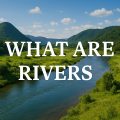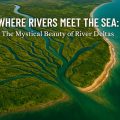Where Rivers Braid: The Fascinating Dance of Braided Streams

Discover the mesmerizing beauty and science of braided streams—where water splits, twists, and reunites in a constantly shifting natural tapestry.
One of the most beautiful forms a river can take is the braided stream—a mesmerizing, ever-changing pattern where water doesn’t follow a single path but splits into multiple intertwining channels. These streams create wide, shallow riverbeds that weave like silver ribbons through blankets of gravel, sand, and silt, constantly shifting with the seasons and flow.
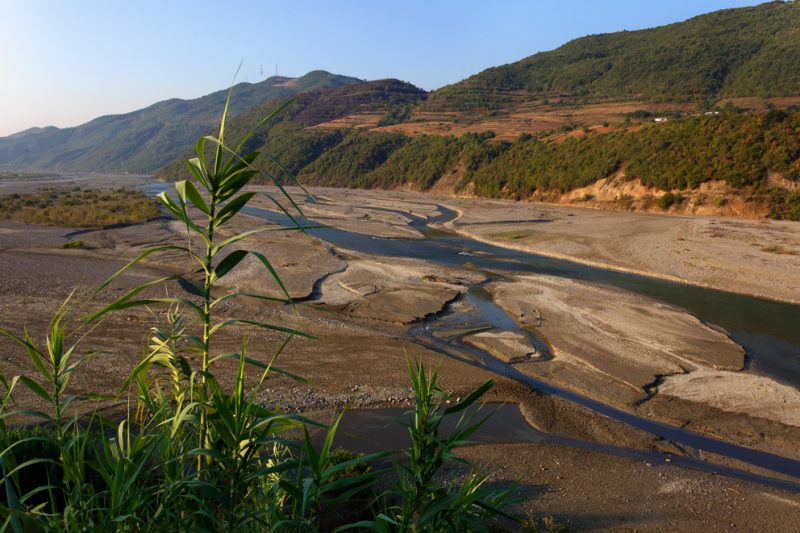
Braided rivers typically form in the middle stretches of a river’s course, where the current has enough energy to carry sediment but not enough to transport it all downstream. However, they can also appear in river deltas, where slowing waters deposit layers of sediment in sprawling, complex networks. The result is a dynamic mosaic of bars and islands, channels and curves—nature’s living tapestry, sculpted by water, sediment, and time.
Curious about how rivers change from source to sea? Dive into our river morphology section.
From Midchannel Bars to Braided Beauty: The Dance of Water and Sediment
When sediment is depositedin the middle of a stream, it forms what’s known as a midchannel bar. This natural obstruction diverts the flow of water toward the stream banks, where the increased force of the current accelerates bank erosion, gradually widening the channel.
In streams carrying a heavy sediment load, this process becomes more complex. Numerous sediment bars can form within the channel, continually reshaping the riverbed. As new bars emerge and water is forced to navigate around them, the stream undergoes repeated cycles of deposition and erosion. These changes are especially pronounced in rivers with fluctuating discharge levels, where the strength and volume of flow vary dramatically over time.
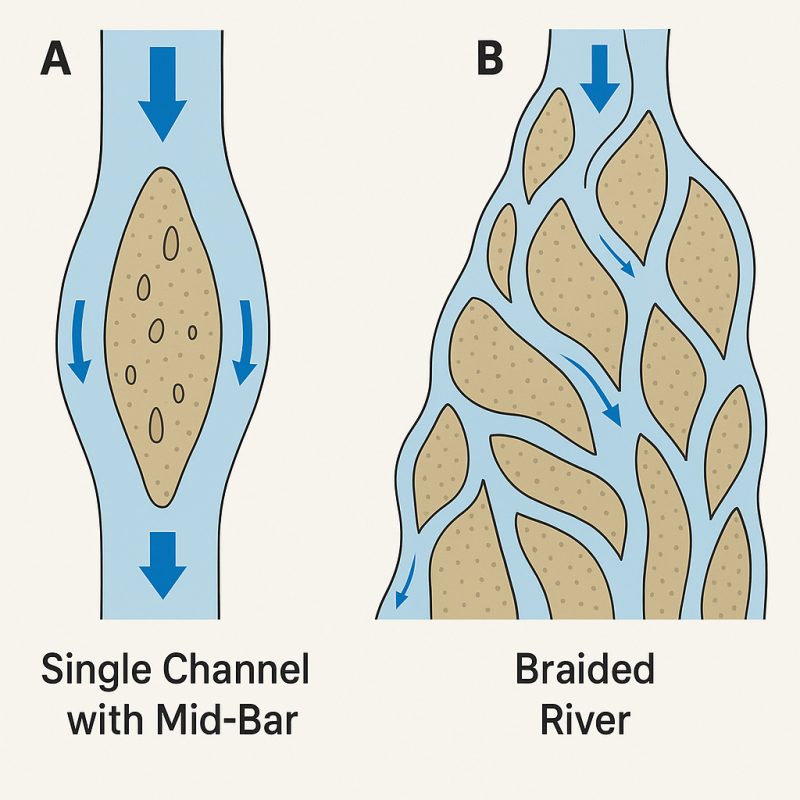
Formation of the braided stream
Over time, if enough sediment accumulates, the main channel can become filled and split into a network of smaller, shifting channels that weave between the bars. This is the hallmark of a braided stream—a river with a broad, shallow channel divided into multiple, ever-changing interconnected rivulets.
During flood events, the entire braided bed is often submerged under a single, swollen current. In these moments, the intricate branching network temporarily disappears beneath the floodwaters, and only the full width of the riverbed is visible.

When Rivers Unravel: Conditions That Create Braided Streams
A river is most likely to develop a braided pattern when it’s burdened with a heavy sediment load, especially bed load, and flows through terrain with easily erodible banks. These conditions allow channels to shift and multiply, weaving through newly formed bars of deposited material.
Braided streams also appear in arid regions, where sediment-laden flows lose water rapidly through evaporation and percolation into the dry ground, reducing their capacity to carry debris and prompting deposition.
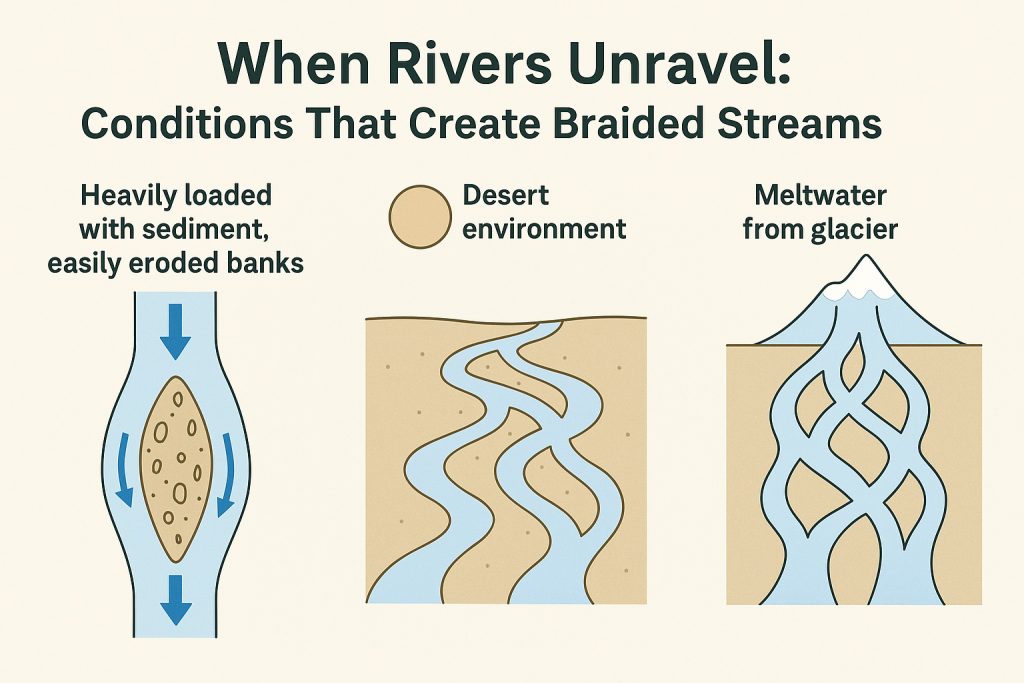
Another striking example is found in glacial environments, where meltwater streams carry large volumes of mixed-size sediment. When the discharge from melting ice is low compared to the overwhelming sediment supply, the stream struggles to transport the material efficiently. The result is a chaotic but mesmerizing web of interlaced channels—a braided stream shaped by imbalance and constant change.
Where Change Nurtures Diversity – The Dynamic Nature of Braided Stream Ecosystems
Braided streams are among the most morphologically unstable habitats in the riverine landscape. Characterized by a network of intertwining channels that constantly shift their course, these environments are in a perpetual state of flux. Bars of gravel and sand appear and disappear with every high flow, reshaping the terrain and creating a mosaic of microhabitats.
Because of this instability, the vegetation that establishes here must be highly adaptable. Most plant species found in braided stream zones are pioneers—those that colonize freshly deposited sediments. They are nature’s first responders, setting the stage for ecological succession but never staying for long, as the next flood may erase the ground they grow on.
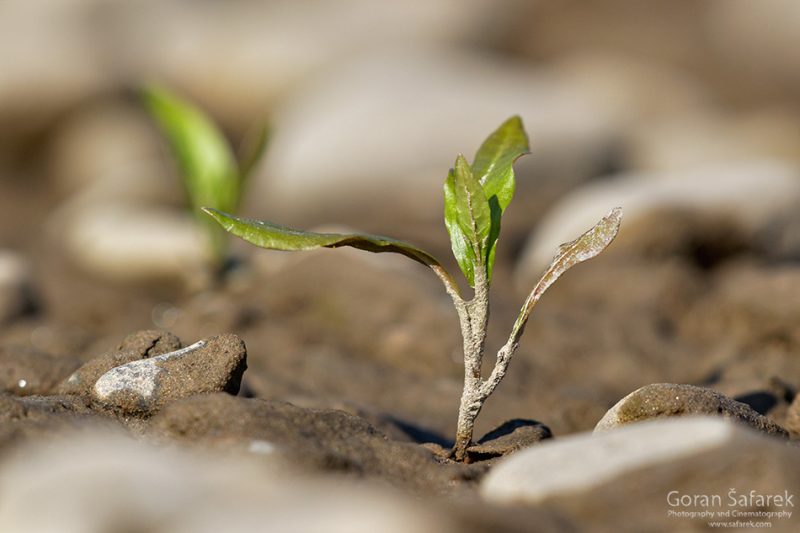
This continual reshaping plays a crucial role in maintaining biodiversity. The frequent disturbances reset ecological succession, preventing any one stage from dominating. Over time, this results in a rich patchwork of successional stages spread across the entire river corridor—from bare sediment bars to mature riparian forests.
In the long run, a single river can support the full spectrum of successional phases and, with them, a wide range of species—each finely tuned to its own ecological niche. In this way, the chaos of braided streams becomes a cradle for life, where diversity thrives in the dance of water and sediment.
Notable Examples of Braided Rivers: Nature’s Ever-Changing Masterpieces
Braided rivers can be found all over the world, particularly in regions where glacial meltwater, steep gradients, or abundant sediment loads create the perfect conditions for this dynamic formation. Here are some of the most remarkable braided rivers that showcase the wild beauty and ecological importance of this fluvial form:
1. The Brahmaputra River – Tibet, India, and Bangladesh
One of the most powerful braided rivers in the world, the Brahmaputra descends from the Tibetan Plateau and snakes its way through the Himalayas before spreading into a vast braided system across the plains of Assam and Bangladesh. During monsoon season, its channels multiply and shift with staggering force. The river is vital for agriculture and transport but also harbors rich biodiversity, including endangered river dolphins and floodplain forests.
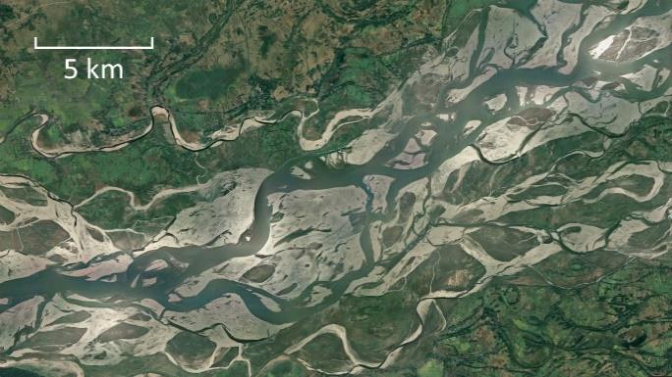
2. The Waimakariri River – New Zealand
Flowing from the Southern Alps across the Canterbury Plains to the Pacific Ocean, the Waimakariri is a textbook example of a braided river. Its silvery threads weave through wide expanses of gravel, creating a constantly changing landscape beloved by both scientists and photographers. It’s also a critical habitat for native birds such as the wrybill and black-fronted tern, species uniquely adapted to this shifting terrain.

3. The Toklat River – Alaska, USA
Winding through the tundra of Denali National Park, the Toklat River is a braided stream that reflects the raw, untamed spirit of the Arctic wilderness. Fed by glacial melt and snowmelt, it twists and sprawls across its valley floor, carving new paths each season. This ever-changing riverbed supports diverse wildlife including grizzly bears, caribou, and wolves, offering a glimpse into one of North America’s most pristine ecosystems.
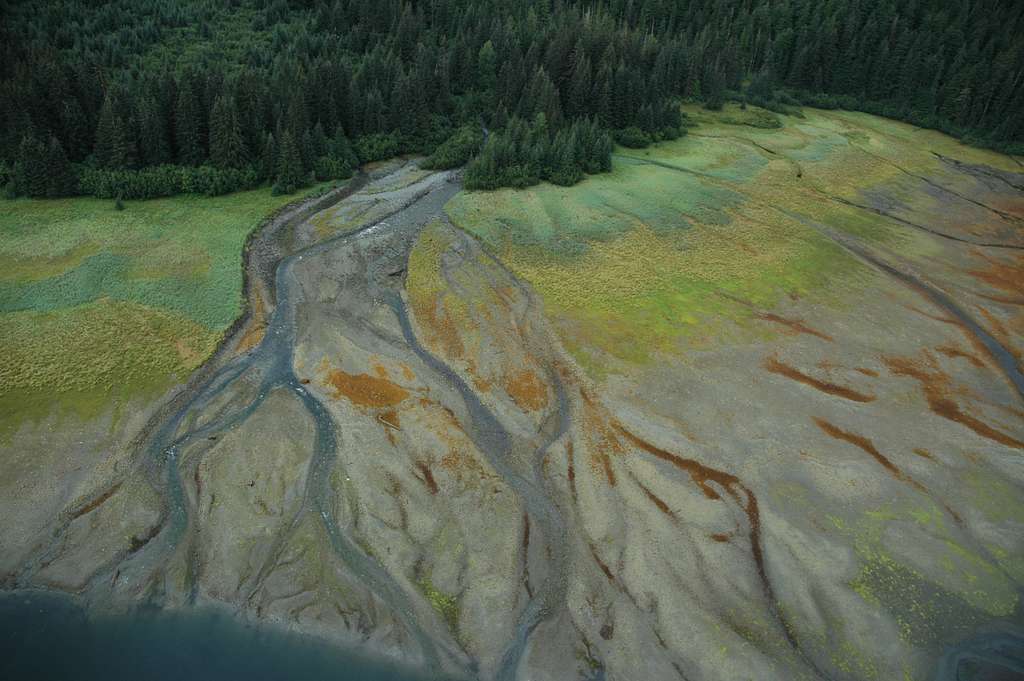
4. The Tagliamento River – Italy
Often called the last wild river of the Alps, the Tagliamento retains its braided structure and natural flood dynamics, a rarity in Europe. It flows through alpine valleys and alluvial plains, creating gravel islands, temporary wetlands, and a myriad of habitats. Conservationists hail it as a living model of riverine diversity, supporting an exceptional array of species from orchids to otters.
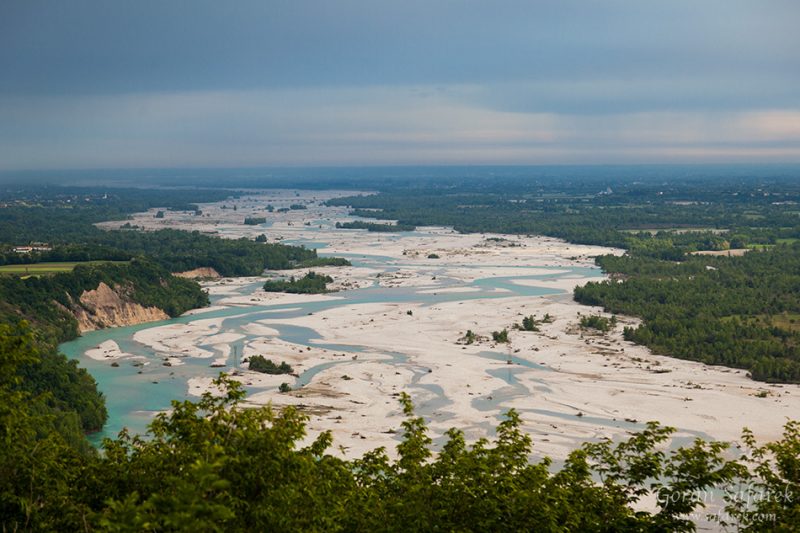
6. The Braided Rivers of Iceland – Fire, Ice, and Fluid Art
Nowhere on Earth do braided rivers look quite as surreal as they do in Iceland. Born from glaciers and volcanoes, these rivers spill across black sands and mossy plains, weaving intricate silver-blue patterns that seem painted from the sky.
Iceland’s braided rivers—Þjórsá, Markarfljót, and Jökulsá á Fjöllum—are striking examples of nature’s artistry, shaped by glacial melt and volcanic terrain. The Þjórsá, Iceland’s longest river, flows in shimmering, mineral-rich braids across black sands, resembling abstract paintings from above. The Markarfljót, born beneath the Mýrdalsjökull glacier, fans out in silty threads near the dramatic Þórsmörk valley. Meanwhile, the mighty Jökulsá á Fjöllum, fed by Europe’s largest glacier, carves through volcanic wilderness on its way to Dettifoss, embodying the island’s raw, elemental power.
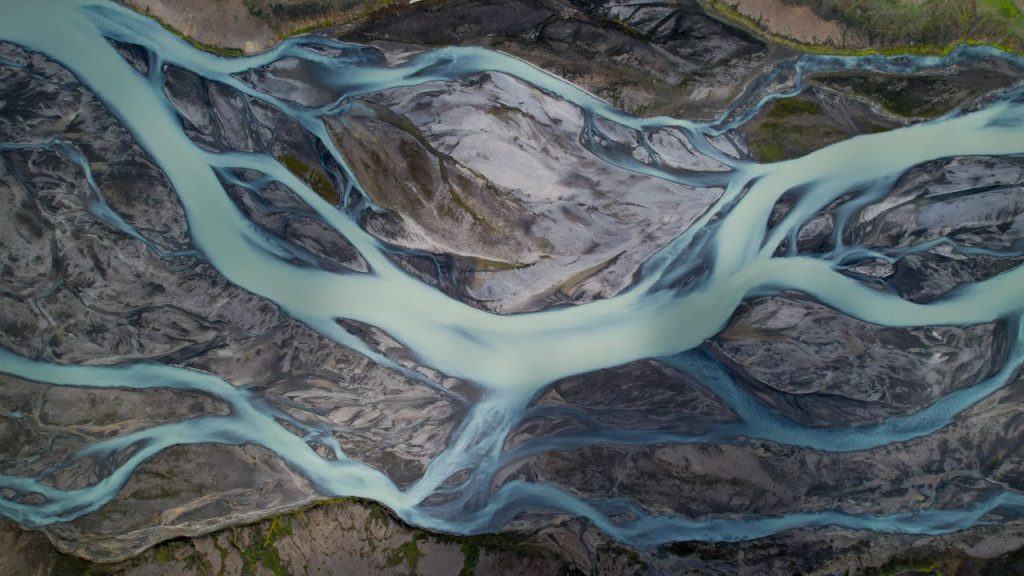
Conclusion: The Living Pulse of Braided Streams
Braided streams are more than just a tangle of channels—they are living, breathing systems that pulse with the energy of water, sediment, and time. Their chaotic elegance fosters biodiversity, resets ecosystems, and tells the story of constant renewal. From the glacial torrents of Iceland to the wild floodplains of the Himalayas, these rivers reveal the beauty in impermanence. In their ever-shifting paths, we find a reminder that nature thrives not in rigidity, but in rhythm, resilience, and the freedom to flow.

